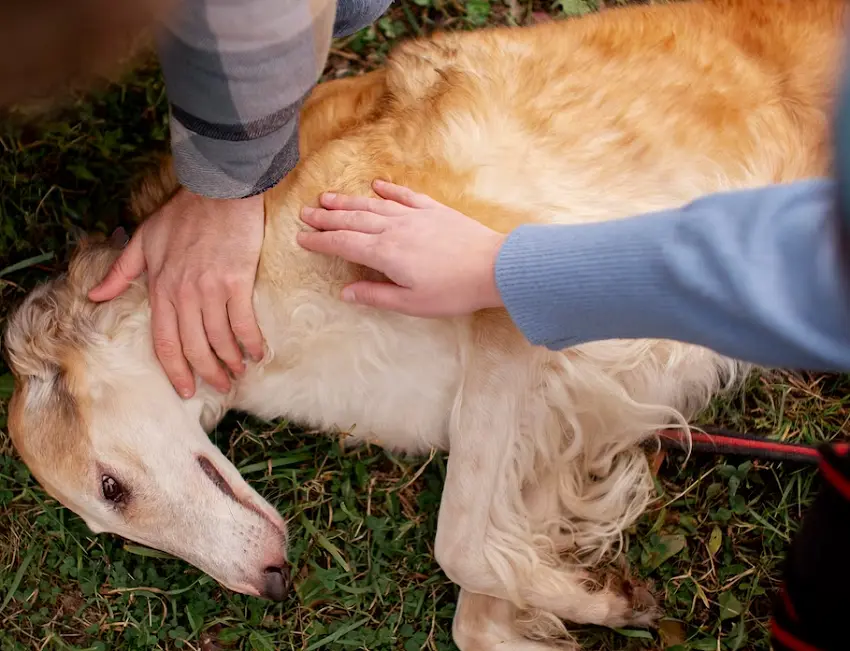5 Natural Ways On How To Help My Dog With Skin Allergies
Like humans, dogs can develop skin allergies. It’s a common problem that can wreak havoc on your canine’s coat.
If your dog is suffering from the same thing, you’re probably wondering, “how to help my dog with skin allergies?”In this post, I have discussed five natural ways you can consider. These are excellent alternatives if your dog isn’t responding well to medications or other treatments.

What causes skin allergies in dogs?
It’s important to know what caused your dog’s skin allergy first. There are many possibilities here, but the following are the most common ones:

Food
Food is the most common reason behind skin allergies among dogs. Dog food allergy occurs when the canine’s body perceives a certain ingredient as harmful even if it’s not. When that happens, the dog’s immune system attacks the body and causes symptoms like severe skin irritation, diarrhea, vomiting, and more.
Take note that dogs can develop an allergic reaction to almost anything. Still, it doesn’t mean that all dogs will have food or skin allergies. It’s a matter of observing your canine and seeing how it will react to its food.
If the dog starts to develop hives after being switched to a new food product, you should consult the vet right away. This might be a case of food-triggered skin allergies. The vet will perform an elimination diet to see what’s really causing the problem.
In an elimination diet, your vet will feed your dog with food with one ingredient missing. So he will know which is the problematic ingredient.
External irritants
Another possible reason here is contact dermatitis. The skin allergy developed due to exposure to an allergen. Pollens and dust are the most common, which is why seasonal allergies among canines are at an all-time high during summer. Dogs with short coats and sensitive skin will be susceptible to these triggers.
Aside from that, toxic substances like soil treatments, cleaning agents, and rubber materials can cause dog skin allergies.
However, if the dog allergy happens all year round at home, you should check the possibility of a mold infestation on your property. Environmental allergy can be tricky to identify, so vigilance is necessary.
Fleas or ticks
Skin parasites are another leading cause of skin allergies. It doesn’t have to be a full-on infestation for your dog to suffer from allergic reactions. A few fleas, ticks, and dust mites are enough to trigger itchiness, redness, and incessant scratching.
The bite itself isn’t the reason why your dog suffers from a flea allergy. It’s the saliva of the insect that will cause irritation on your dog’s skin.
The weird thing here is that skin allergies due to fleas are more common on canines that are only bitten occasionally. It’s possible that the body hasn’t built a tolerance and perceives the random bites as a major threat to the animal’s body.
Staphylococcus hypersensitivity
Lastly, some dogs have a skin condition called Staphylococcus hypersensitivity. This occurs when a canine becomes abnormally sensitive to normal levels of Staphylococcus bacteria on the skin.
Take note that Staphylococcus hypersensitivity can be secondary to a flea infestation and other causes mentioned above.
How to help my dog with skin allergies?
If your dog is suffering from skin allergies, the following are natural solutions you can try. Most of the time, these solutions are harmless and can be used on almost every canine.
But if your dog has a serious condition, it’s always best to ask the veterinarian.

1. Oatmeal bath
Oatmeal is widely known to soothe itchy and dry skin. I personally take oatmeal baths when I have skin irritations, which helps a lot in easing the discomfort. This is the same thing I did with my dog Sherlock when he developed skin allergies.
Oatmeal helps soak the excess sebum on the dog’s skin. It also has anti-inflammatory and antioxidant properties that will help soothe your pet’s skin. Oatmeal also contains natural cleansers called saponins, which exfoliate the skin.
To prepare an oatmeal bath, grind plain oatmeal until it’s powdery. Sprinkle this on a warm bath and let your dog soak in it for 15 minutes. This should reduce the itchy and burning sensation brought by the skin allergy.
If you can’t give your dog a full bath, you can add water to the ground oatmeal until you come up with a pasty consistency. You’ll spot treat your dog on the areas with visible irritations.
2. Coconut oil
Another natural solution you can give your dog with allergies is coconut oil. Many consider coconut oil as liquid gold when it comes to skin problems. My cat Watson once had bald spots due to skin irritation. We apply coconut oil to it, and it only took a few days for the problem to clear up. This can have the same effect on your dog’s skin allergies.
Coconut oil is very effective if your dog has flea or tick infestation. This oil kills fleas and ticks on contact, which will drastically reduce the bites on your dog. Also, it will soothe pre-existing bites and hotspots.
The best thing is that coconut oil is natural and food-grade. You won’t have to worry if your dog licks it.
3. Herb soaks
Herb soaks made of chamomile, and green tea can also help dogs suffering from skin allergies. You can also add calendula to the mix. This soak is a good choice for dogs with flaring skin and hot patches that just won’t go away.
You just have to fill your tub with warm water and steep tea bags on it. After a few minutes, remove the tea bags and let your dog soak on it for five minutes. This should help reduce the inconsolable itch.
If a bath isn’t possible, you can also spot-treat your dog allergies. Simply steep the tea in warm water and use a cotton ball to dab it to your dog’s skin.
4. Plain yogurt
Feeding plain yogurt to your dog with skin allergies can help alleviate its suffering. While this doesn’t offer instant results, a small serving of yogurt will help reduce food allergy symptoms. It will ease your dog’s gut and potentially help reduce the itchiness of the skin.
Also, yogurt is packed with natural probiotics that can fight yeast infection among canines. Aside from that, yogurt is rich in calcium and protein that will benefit your dog.
5. CBD oil
Lastly, you can also consider the use of CBD oil. There are many dog lovers who believe CBD can oil help dog with skin allergies. The anti-inflammatory properties of CBD oil make it a soothing option for canines with allergies.
CBD oil added to the dog’s food or treats can help alleviate the skin’s swelling. It also provides relief from the pain and itchiness. This calms your dog and helps it rest for recovery. Read more here: CBD Oil For Dogs vs Humans
Take note that CBD oil is only one of the remedies. You still need to consult your dog’s vet to pinpoint the cause of allergies and how to properly treat it.
So far, there’s no known case of CBD allergy among canines. Some vet clinics even recommend it to pet owners, considering that such products are legal in that state or locality.
How do I get my dog to stop scratching?
To get your dog to stop scratching, you first have to know what’s causing the habit in the first place. It could be skin allergies, compulsive behavior, or flea infestation.
You have to treat the cause, so your dog won’t suffer from itchiness, leading to incessant scratching. It’s best to bring your dog to the vet for a proper diagnosis. Your dog may need to undergo allergy testing.
Can you give a dog Benadryl to stop itching?
Benadryl is widely used to ease the itchiness due to dog skin allergies. It’s also effective in alleviating swelling, hives, and other related symptoms.
However, you should mind the dosage. Most of the time, vets recommend 1 mg of Benadryl for every pound of a dog’s body. You can give this to your dog two to three times a day to help with the symptoms.
Just remember that Benadryl isn’t a cure for allergies. You still need to tackle the root cause of the skin problem to save your dog from suffering.
Can I sprinkle baking soda on my dog’s itchy skin?
Baking soda can help dry out your dog’s skin rashes. You just have to mix it with water and spot treat the affected areas. However, if your dog’s condition worsens, stop using baking soda right away. It’s also better to consult the vet before using any of these home remedies.
What do vets prescribe for itchy dogs?
For unbearable itch, veterinarians will prescribe a steroidal medication for dogs. They will also recommend the use of medicated shampoo and oral medications. Topical medicine is also very likely as well as allergy shots. Read more here: Best Dog Shampoo For Allergy Sufferers
Take note that the vet’s prescription will vary widely, depending on your dog’s condition. You should avoid using human medicines on your dog in an effort to alleviate its allergy. It may do more harm than help.
There are some medicated foods for dogs as well. You can try dog foods for allergic dogs after consultation with your vet.
Conclusion
Knowing how to help my dog with skin allergies didn’t come easy. But with the vet’s help, I was able to give Sherlock the treatment his skin needed. This rings true for all dogs suffering from skin problems like allergies. Just remember that as much as home remedies help, they are not an absolute cure. The vet is always the best person to ask about your dog’s condition.
I hope the information from this article will help you take better care of your dog’s skin.
Thank you for reading and keep on enjoying life with your lovely dog!
